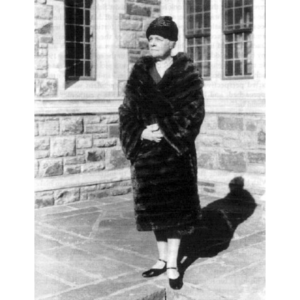Minnie Cumnock Blodgett
by Julia Bouwkamp
Life Dates: b. 1862, d. October 13, 1931
Full Name: Minnie Cumnock Blodgett
Birthplace: Lowell, MA
Tags: Medicine
In 1917 as Americans prepared to enter World War I, worries about an impending nursing shortage abounded. Just how would American hospitals function when thousands of trained nurses shipped out for work on the front lines?
Nursing leaders instituted a national recruitment campaign. But then another problem loomed large: how to train new recruits well enough and fast enough to meet wartime demands. Because nurses had been traditionally considered unskilled laborers requiring little medical training, American nurses had long campaigned for mandated professional standards. The nursing advocates who had emphasized the scientific and intellectual side of their profession could not now simply abandon their serious principles for wartime expediency.
One solution to this conundrum was presented by prominent Grand Rapidian Minnie Cumnock Blodgett. As a trustee of her alma mater, Vassar College, she was in a position to contribute beyond the important donation, made with her husband John W. Blodgett, to build Blodgett Memorial Hospital. In June 1917, as chair of Vassar’s committee to plan the college’s contribution to the war effort, Cumnock Blodgett proposed an intensive summer program in nursing to be conducted on the campus grounds. Once endorsed by the Council of National Defense and granted $75,000 by the Red Cross, a “nursing boot camp” was begun. When they had completed a rigorous three-month educational program, graduates were dispersed to hospitals throughout the country to begin the practical portion of their training and to take over for nurses readying for deployment.
Memorable in itself as a historic war measure, the Vassar Training Camp for Nurses had a continuing influence. Student nurses, including those training locally at the Blodgett and Butterworth hospitals, had struggled to balance necessary coursework with the demands of their hospitals. Cumnock Blodgett’s crucial contribution to nursing education was to separate theoretical training from the practical training received on the floors of hospitals. The Vassar Camp had proven a new strategy for structuring nursing education–one which prioritized nurses’ intellectual aspirations and pushed back against the perception of nurses as unskilled laborers. Blodgett herself described the program as “giving scientific value to the business of being a woman.”

Confident in the success of her work at Vassar, Blodgett encouraged Grand Rapids nursing programs to partner with Grand Rapids Junior College for their students’ coursework, affording a learning environment wholly separate from the distractions of the hospital settings.
In their separation of practical and theoretical training, both the Vassar program and the Grand Rapids partnership served as important precursors for the many undergraduate pre-professional programs that today still prepare students for the nursing profession. Both efforts owe their existence to the foresight and leadership of Minnie Cumnock Blodgett.
Three years after the Vassar Training Camp had prepared over 400 women for nursing careers, alumnae convened for a post-war reunion. In the Vassar Chapel they memorialized their colleagues who had died fighting the Spanish Influenza. A second wave of this deadly plague had gripped the nation in the fall of 1918 as the First World War sputtered to a close. Worldwide, the pandemic took the lives of an estimated fifty million people–far exceeding the twenty million lost to the war.
An Early STEM Advocate
After WWI, Minnie Cumnock Blodgett continued her work advocating for women in science and for public health projects. Upon her death from a heart attack in 1931, the 68-year-old Blodgett was memorialized in an extensive front-page article of the Grand Rapids Press. Neither that celebration of her life nor ours can offer more than a short list sampling her many contributions. She worked to found the Grand Rapids Clinic for Infant Feeding, led the Delos A. Blodgett Home for Children, and was appointed to the Michigan State Welfare Commission and the National Order of Public Health Nurses. As an effective advocate of the new science of birth control, Blodgett was also instrumental in bringing the pioneering Margaret Sanger to Grand Rapids to speak.
Sources
This biography can also be found in the April 2020 issue of the Grand Rapids Women’s LifeStyle magazine.

